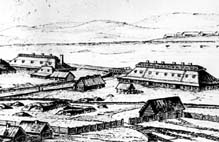
The Barnaul Silver Plant, built 1790
Reconstruction of nowadays
|
The appearance of the Siberian mining industry in the 18th c. became an important event in the history of Russia which hastened the discovery of its eastern areas.
The plants were the hearthes of culture including such main objects as dams, industrial buildings (melting factories, warehouses and laboratories), public buildings (churches, colleges, schools, museums and libraries), administrative buildings (offices, archives), apartment houses for officials, and officers barracks.
The plans of the Kolyvano-Voskresenskiy, Barnaulskiy and Shulbinskiy plants of the 1720-s--1740-s are the most ancient plans of the Siberian construction. In exploring them we can make certain conclusions.
|
The construction of the Altai towns-plants region was influenced by the experience of erecting Siberian fortified towns which combined the ancient Russian traditions and the experience of Ural construction. Ancient Russian traditions were displayed in the character and location of fortifications, in the free location of a religious building on an open square and in the inclination towards a concentric planning of a factory settlement. These prerequisites in the Siberian plants led to the appearance of a compact center which would include the areas of a plant's territory as well as industrial buildings. These prerequisites were created on the base of the Ural experience which, in its turn, used the European experience.
